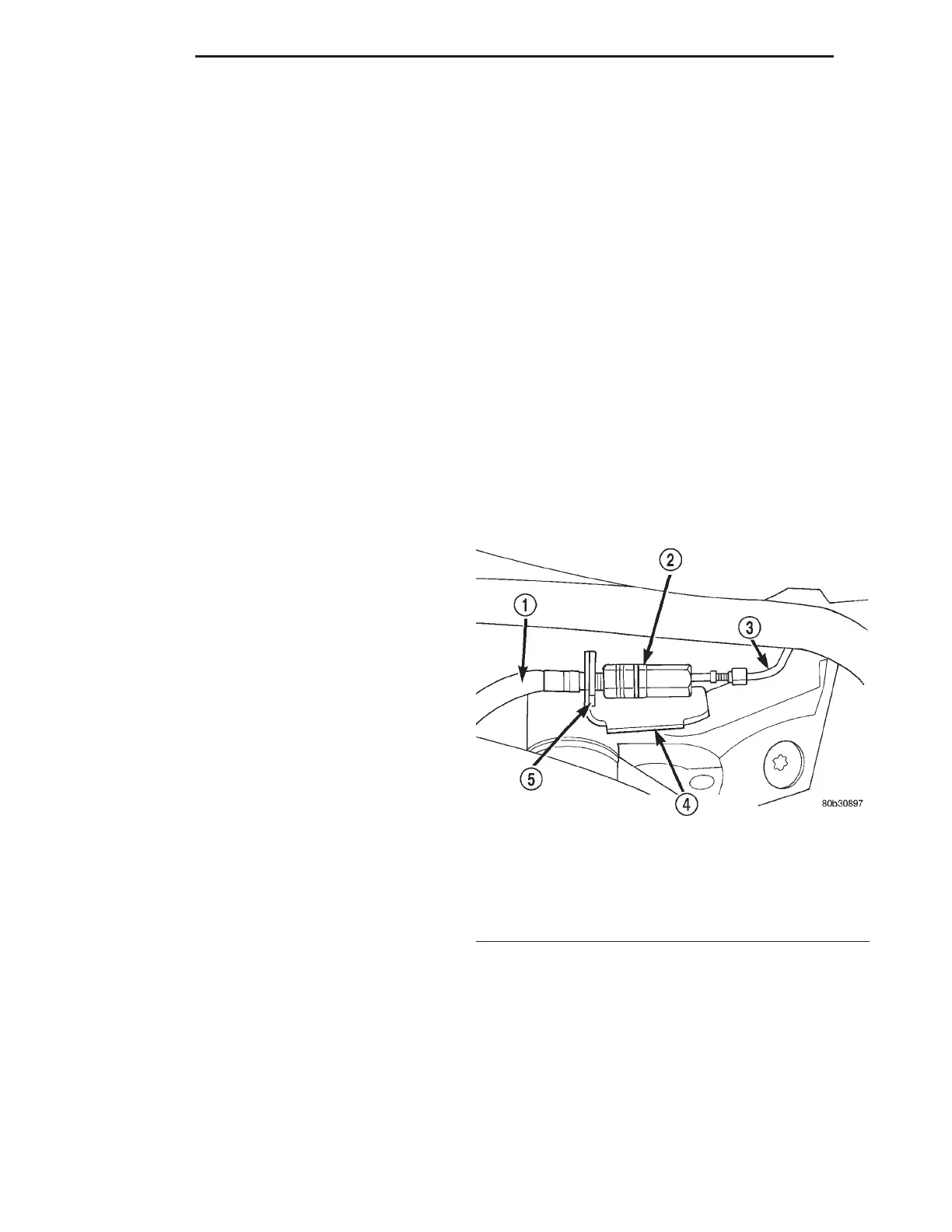inches, the hose or check to the booster has a restric-
tion or leak.
Once an adequate vacuum supply is obtained,
repeat the BASIC TEST.
VACUUM LEAK TEST
(1) Disconnect the vacuum hose on the side of the
power brake booster vacuum check valve that leads
to the speed control, then connect a vacuum gauge to
the open vacuum port on the valve.
(2) Remove the remaining hose on the vacuum
check valve that is not the vacuum supply hose com-
ing from the intake manifold. Cap off the open port
on the check valve.
(3) Start the engine.
(4) Allow the engine to warm up to normal operat-
ing temperature and engine idle.
(5) Using vacuum line pliers, close off the vacuum
supply hose near the booster and observe the vacuum
gauge.
If the vacuum drop exceeds 1.0 inch Hg (3.3 kPa)
in one minute, repeat the above steps to confirm the
reading. The vacuum loss should be less than 1.0
inch Hg in one minute time span. If the loss is more
than 1.0 inch Hg, replace the power brake booster. If
it is not, continue on with this test.
(6) Remove the pliers from the hose temporarily.
(7) Apply light effort (approximately 15 lbs. of
force) to the brake pedal and hold the pedal steady.
Do not move the pedal once the pressure is applied
or the test results may vary.
(8) Have an assistant reattach the pliers to the
vacuum supply hose.
(9) Allow 5 seconds for stabilization, then observe
the vacuum gauge.
If the vacuum drop exceeds 3.0 inches Hg (10 kPa)
in 15 seconds, repeat the above steps to confirm the
reading. The vacuum loss should be less than 3.0
inches Hg in 15 seconds time span. If the loss is
more than 3.0 inches Hg, replace the power brake
booster. If it is not, the booster is not defective.
PROPORTIONING VALVE
PROPORTIONING VALVE TEST (WITH AND
WITHOUT ANTILOCK BRAKES)
CAUTION: Not all components use the same type
tubing flare. The tube leading into the proportioning
valve has an ISO flare, while the flex hose coming
out of the proportioning valve has a standard dou-
ble-inverted flare. Use the correct adapters when
installing gauges to test proportioning valves.
Both vehicles, with Antilock Brakes, and without
Antilock Brakes, have two proportioning valves. One
valve is connected to each rear flex hose. One propor-
tioning valve controls the right rear brake, and the
other proportioning valve controls the left rear brake.
On vehicles without ABS, if premature wheel skid
occurs on a hard brake application, it could be an
indication that a malfunction has occurred with one
of the two rear brake proportioning valves. Test the
valve that controls the side of the vehicle on which
the skid occurs.
On vehicles with ABS, if premature rear wheel
ABS cycling occurs on a hard brake application, it
could be an indication that a malfunction has
occurred with one of the two proportioning valves.
Since ABS cycles both rear brakes together, both
valves must be tested to isolate the suspect propor-
tioning valve.
(1) Raise the vehicle on jack stands or centered on
a hoist. See hoisting in the Lubrication and Mainte-
nance section of this manual.
(2) Clean any debris away from the suspect pro-
portioning valve, connections, and area.
(3) Remove the chassis brake tube (Fig. 15) from
the suspect proportioning valve.
(4) Remove the proportioning valve from the rear
flex hose which is held stationary by a bracket
mounted on the back side of the crossmember.
(5) Remove the retainer clip securing the rear flex
hose from its bracket (Fig. 15). This should be
done to allow the proportioning valve pressure
test fittings to be installed without bending the
chassis brake tube.
Fig. 15 Proportioning Valve
1 – FLEX HOSE
2 – PROPORTIONING VALVE
3 – BRAKE TUBE
4 – BRACKET
5 – RETAINER CLIP
5 - 14 BRAKES LH
DIAGNOSIS AND TESTING (Continued)

